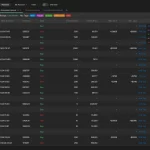As the United States navigates through an election year, discussions surrounding inflation take center stage, with critics arguing that the official numbers fail to capture the true extent of rising prices. Amidst these debates, the Federal Reserve’s potential actions, particularly in the lead-up to the election, come under scrutiny.
The primary gauge for inflation, the personal consumption expenditures (PCE) price index, revealed a 0.3% increase in January, aligning with expectations. However, the 12-month headline inflation rate slightly eased to 2.4%, matching estimates.
While Federal Reserve decisions traditionally lean on core inflation, which excludes volatile food and energy prices, the core PCE index also rose by 0.4% in January, in line with forecasts. Yet, the core 12-month inflation rate saw a slight decrease to 2.8% from 2.9% in December, aligning with Wall Street predictions.
Delving deeper into the numbers, the unrounded figures paint a less rosy picture. Core inflation actually rose by 0.42% on the month, with an annual increase of 2.849%. On a three-month annualized basis, the primary core inflation rate surged to 2.6% from an upwardly revised 1.6% in December. Similarly, on a six-month annualized basis, core inflation accelerated to a 2.5% rate, up from a mild 1.9% in December.
Federal Reserve Chair Jerome Powell has emphasized the importance of observing six months of subdued inflation data to ensure the longevity of any disinflationary trends. The upcoming months will provide crucial insights, particularly in assessing core services inflation beyond housing, a key focus for the Fed.
In tandem with the PCE price index, the Commerce Department’s monthly report on personal income and outlays revealed a noteworthy surge of 1% in personal income for January, surpassing forecasts of 0.4%. However, personal consumption expenditures saw a more modest increase of 0.2%, as anticipated.
Anticipation of potential Federal Reserve rate cuts has been mounting, with market pricing indicating increasing odds of a cut by mid-2024. Ahead of the January PCE report, the market showed a 19% probability of the first rate cut by the May 1 meeting, with odds of a cut by June 12 standing at 57%. These projections suggest a year-end 2024 Fed funds rate of 4.6%, implying three quarter-point rate cuts throughout the year.
Following the inflation data release, S&P 500 futures reversed higher, climbing 0.4% in early Thursday morning stock market action. Meanwhile, the 10-year Treasury yield edged up one basis point to 4.28%, albeit relinquishing an earlier increase as bond traders anticipated the inflation report.
As discussions on inflation persist, investors closely monitor the Fed’s stance and market reactions, seeking insights to inform their trading decisions amidst evolving economic conditions. Stay updated with IBD’s The Big Picture column for comprehensive analysis on prevailing stock market trends and their implications.
Here are some reasons why the US government debt and the printing of money could lead to higher inflation:
- Increased Money Supply: Printing money to finance government debt leads to an increase in the money supply. When there is more money in circulation relative to the available goods and services, it can result in higher prices, as each unit of currency becomes less valuable.
- Demand-Pull Inflation: Higher government spending financed by debt or money printing can boost aggregate demand in the economy. If demand increases faster than supply, it can lead to demand-pull inflation, as consumers and businesses compete for limited resources, driving prices higher.
- Monetization of Debt: If the government directly purchases its own debt from the market by printing money, it effectively monetizes the debt. This can erode confidence in the currency and lead to inflationary expectations among investors and consumers.
- Devaluation of Currency: Excessive money printing can result in the devaluation of the currency relative to other currencies. A weaker currency makes imports more expensive, leading to higher prices for imported goods and contributing to inflation.
- Interest Rate Pressures: To control inflation resulting from excessive money printing, central banks may raise interest rates. Higher interest rates can increase the cost of borrowing for businesses and consumers, potentially slowing economic growth. However, if interest rates remain low despite inflationary pressures, it can exacerbate inflation by encouraging more borrowing and spending.
- Loss of Confidence: Persistent government debt and money printing can undermine confidence in the economy and the currency. If investors and consumers lose faith in the government’s ability to manage its finances responsibly, they may demand higher returns to compensate for the perceived risk, further fueling inflation.
- Inflation Expectations: Expectations play a crucial role in determining inflation. If businesses and consumers anticipate higher future inflation due to government debt and money printing, they may adjust their behavior accordingly, demanding higher wages and prices, which can become self-reinforcing.
- Wealth Redistribution: Inflation can redistribute wealth from savers to borrowers. Those holding assets denominated in currency, such as cash or bonds, may see the real value of their holdings eroded by inflation, while borrowers benefit from repaying their debts with less valuable currency.
Overall, while government debt and money printing can provide short-term economic stimulus, they also pose risks of long-term inflationary pressures if not managed prudently. Balancing fiscal and monetary policies to promote sustainable economic growth while maintaining price stability is essential to mitigate the risk of inflation.
Shayne Heffernan









